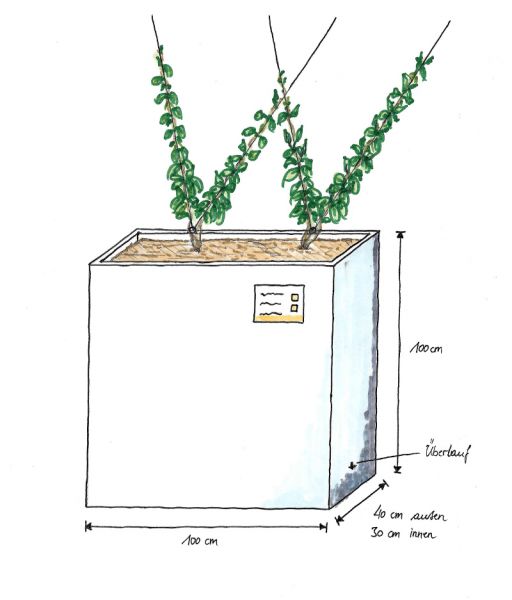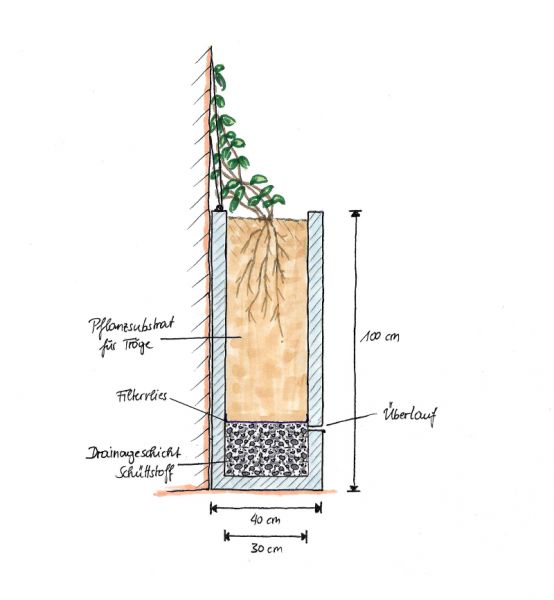50 green houses - Development and demonstration of a low-tech façade greening system
Short Description
Climate forecasts for Central Europe show that we will have to prepare for even hotter summers in the future. Due to the high degree of soil sealing, some surfaces heat up during the day, then retain the heat and hardly cool down at night. This problem is also known as the Urban Heat Island Effect. An effective method of cooling existing neighbourhoods and streets lies in street-sided facade greening. It is especially important that the greening and cooling effects are implemented where they are needed the most: near asphalted streets and in densely built-up areas. To date, facade greening has been implemented primarily in new construction projects. However, existing buildings represent the building sector with the greatest potential for implementation - "retrofitting" buildings with facade greening has been rather unappealing up until now, because the necessary handling and approval processes were quite complex and there was no facade greening solution that was technically easy to implement. Therefore, although there is great potential for facade greening on existing buildings, at the beginning of the "50 Green Houses" project in 2018, no cost-effective, easy-to-implement overall solution existed for this yet.
The aim of the "50 Green Houses" project was therefore, together with the City of Vienna, to develop and test the first integrated all-in-one solution for easy-to-handle facade greening on existing buildings. This green innovation is the first to enable a broad application of vertical greening by means of a low-tech plant trough solution, optionally with or without climbing aids, in the entire urban building stock and thus contributes measurably to the protection against summer overheating and to the improvement of comfort and quality of life in the densely built-up city. Researching social aspects (including the involvement of users in the maintenance of the vertical greening) among other things, aims at ensuring the long-term functionality of the vertical greening.
At the beginning of the research project, technical and ecological requirements were determined in coordination with the administration and targeted surveys were conducted in the form of interviews with future users and focus groups under the involvement of the administrative departments. This way, the requirements and approval processes of the City of Vienna could be analysed, and the overall concept adapted optimally to the needs of the building residents and owners.
Based on these findings, an integrated combination solution was developed as an All-In-One package consisting of the BeRTA green facade module and the web filing tool:
- The BeRTA green facade module consists of a planter, root habitat, climbing aid, plants including care instructions and fits almost all facade situations in the city due to its variable design options. In addition, the BeRTA green facade module is specially adapted to the requirements of public spaces and the implementation on existing buildings. A wide range of requirements were taken into account in the development: the use of durable and ecological materials, appropriate dimensioning (sufficient root habitat with at the same time the greatest possible residual sidewalk width), site-appropriate plant selection and suitable maintenance concepts.
- The BeRTA web filing tool simplifies all the coordination processes necessary for the greening: this includes checking the required sidewalk width, owner consent forms, approvals of the green facade by the City of Vienna and coordination of the various trades involved.
The entire project was accompanied by comprehensive communication measures to raise awareness and publicize the project, as well as a separate work package that dealt with the legal terms.
In spring 2019, owners, tenants and property managers were able to apply online via the website www.50gh.at for the first 50 prototypes of the BeRTA green facade module, which were allocated free of charge through the research project. An online form guided interested parties step-by-step through the submission process, quickly and easily requesting all necessary data. An expert jury then used transparent criteria to select the buildings for implementation. The first BeRTA green facades were installed on nine buildings in Vienna's Inner Favoriten district in November 2019. The evaluation was ongoing from fall 2019 to summer 2021: Vegetation measurements provided information about the condition of the plants and in a sociological monitoring, the building residents' and maintenance officers' perception was surveyed. The results show a high level of satisfaction with the process and the overall BeRTA module system.
There was a high demand for the greening solution: there were over 700 expressions of interest when the first 50 modules were allocated. Due to the high interest and the city's greening needs, the results of the research project were put into practice while the project was still in progress. BeRTA became available to the entire city in spring 2020 and can be obtained at www.berta-modul.at. First BeRTA greening projects outside the target area have already been implemented, e. g. in Rotenturmstraße in the first district near Stephansplatz, in Albertgasse in the eighth district or in Dreihackengasse in the ninth district.
Numerous other BeRTA greening projects are already in the planning stage; and work is underway with the Climate and Energy Fund and the Association of Cities to transfer the BeRTA facade greening innovation to other Austrian cities. In addition, active efforts are being made to establish a BeRTA network with qualified companies from the fields of consulting, planning and landscaping, and to further develop the BeRTA offerings in order to make cities greener and more liveable and to counteract urban heat islands.
Project Partners
Project management
Victoria Hala, MSc., tatwort Nachhaltige Projekt GmbH
Project or cooperation partners
- GrünStattGrau Forschungs- und Innovations GmbH
- Die Wiener Volkshochschulen GmbH – DIE UMWELTBERATUNG
- Wiener Umweltschutzabteilung (MA22) der Stadt Wien
- Universität für Bodenkultur Wien (BOKU), Department für Bautechnik und Naturgefahren, Institut für Ingenieurbiologie und Landschaftsbau (IBLB)
Contact Address
tatwort Nachhaltige Projekt GmbH
Haberlgasse 56/17
A-1160 Wien
Tel.: +43 (1) 409 55 81
Fax: +43 (1) 409 55 81 - 20
E-Mail: tatwort@tatwort.at
Web: www.tatwort.at


